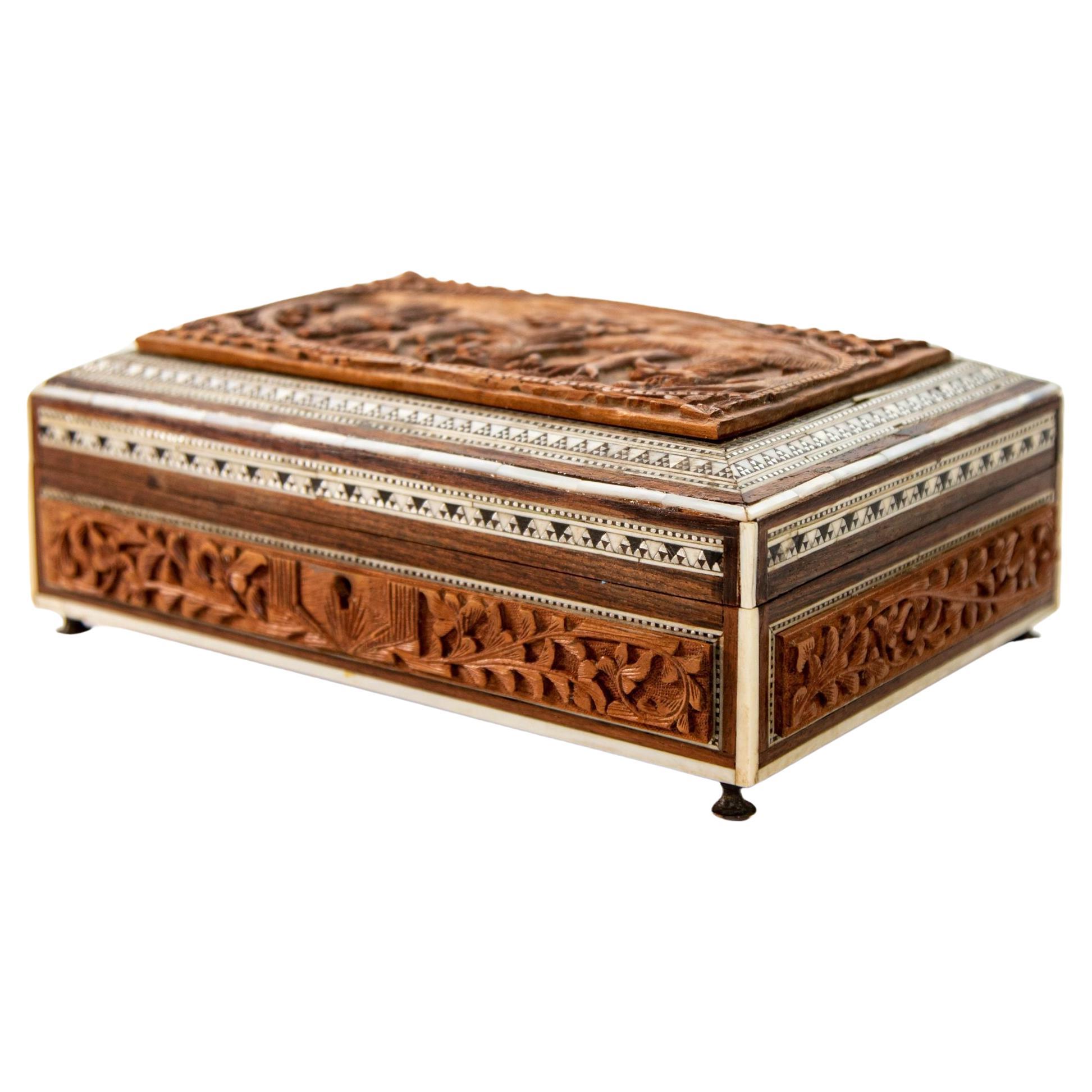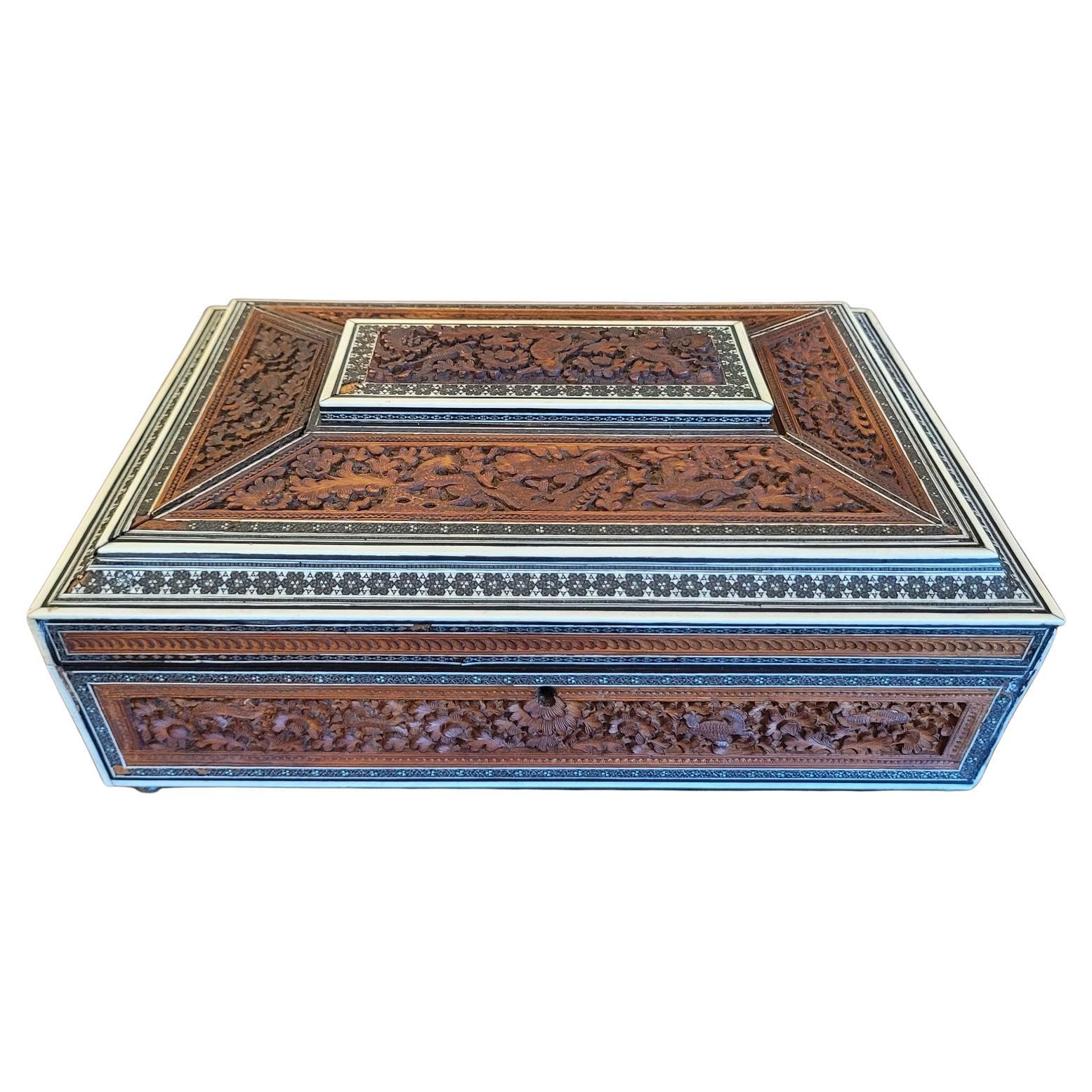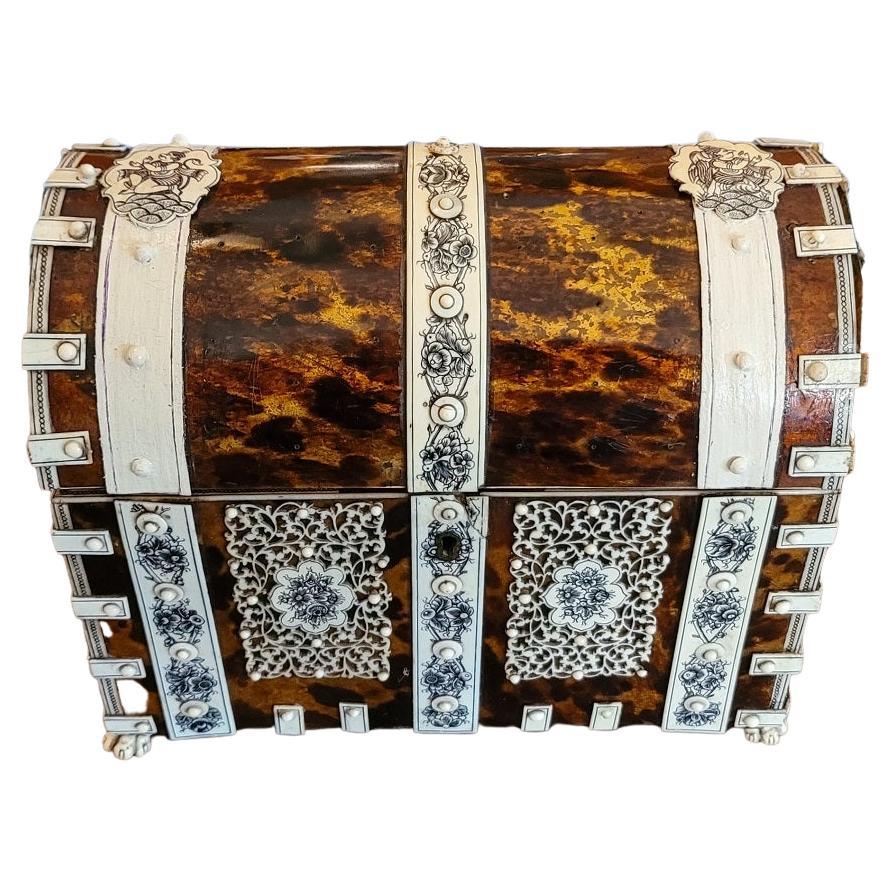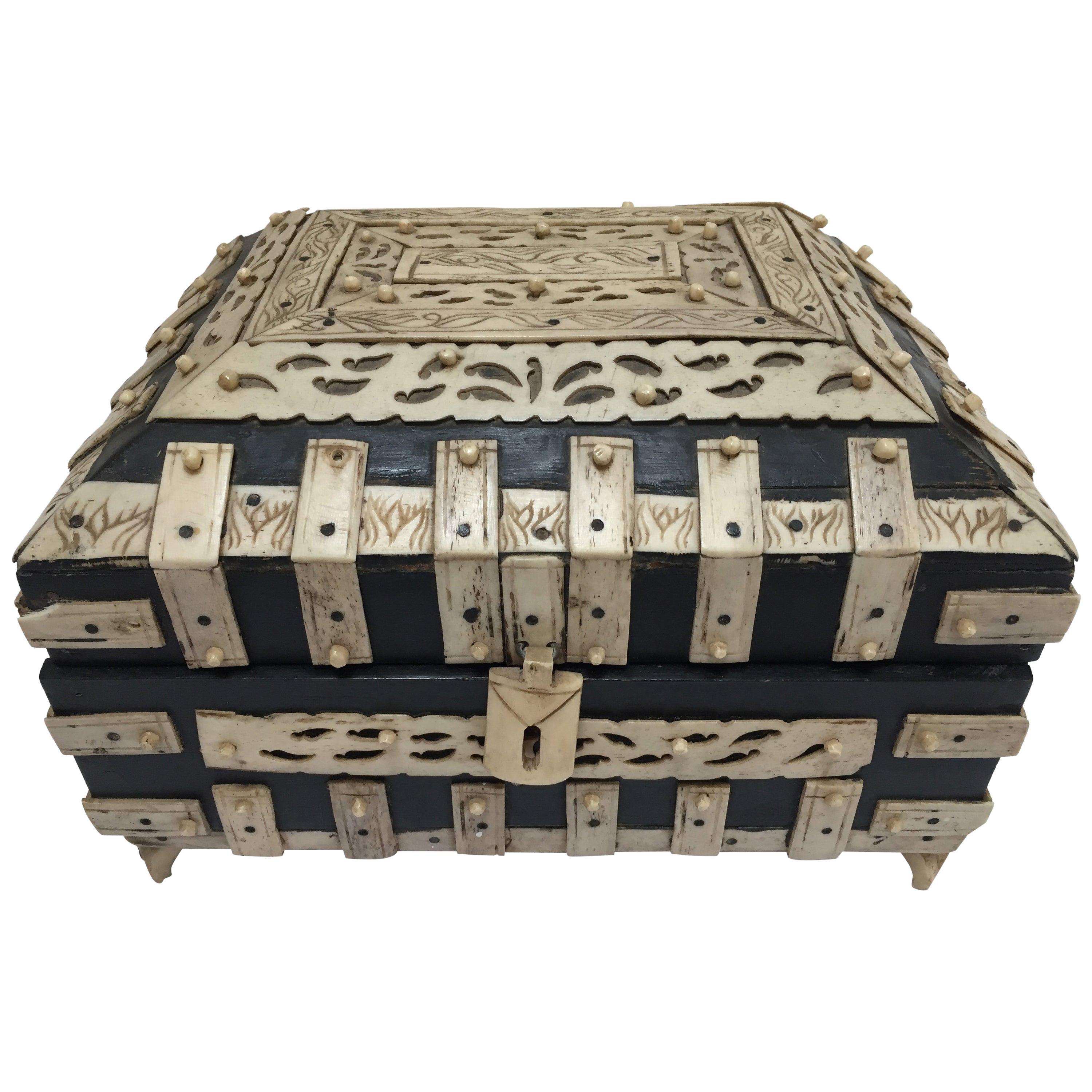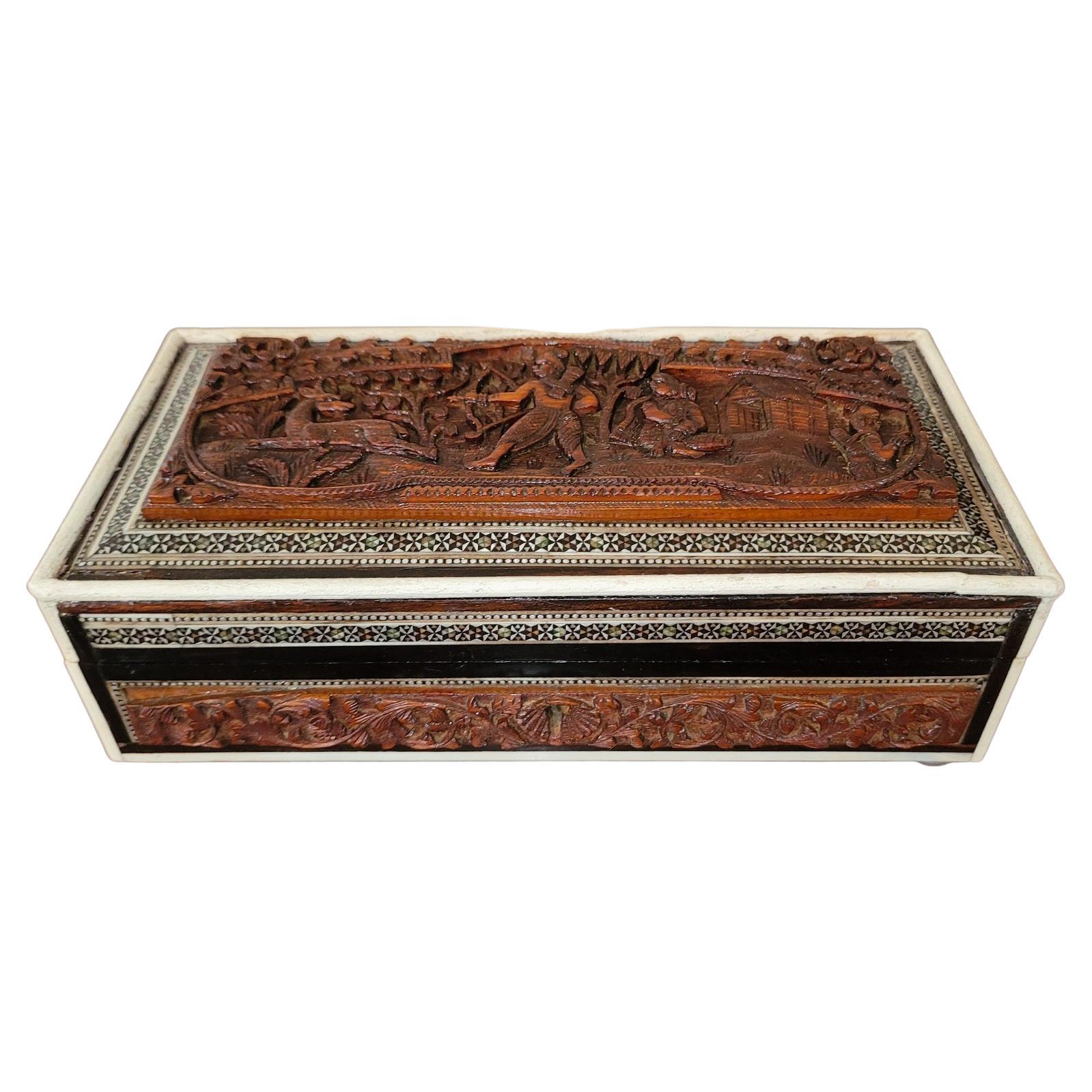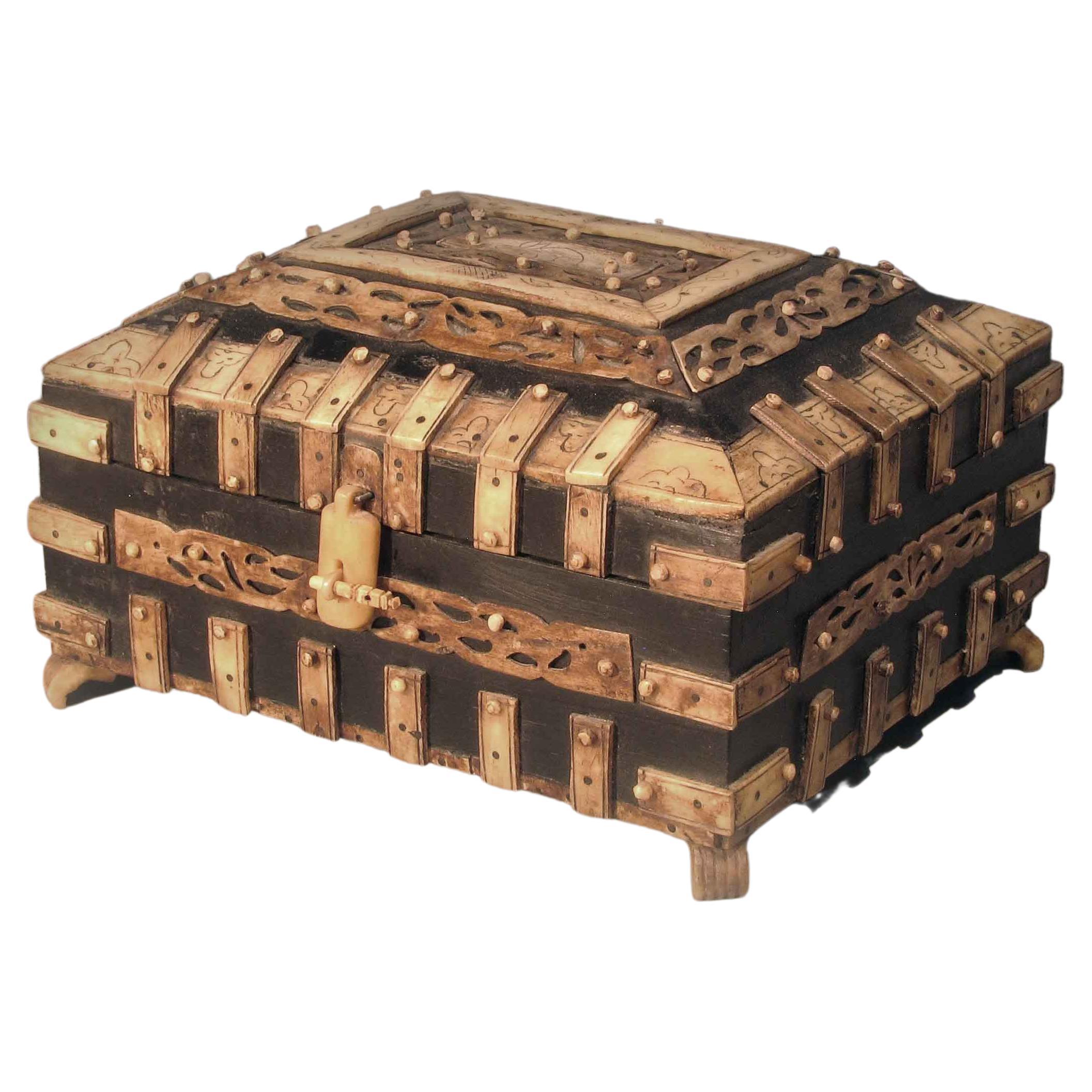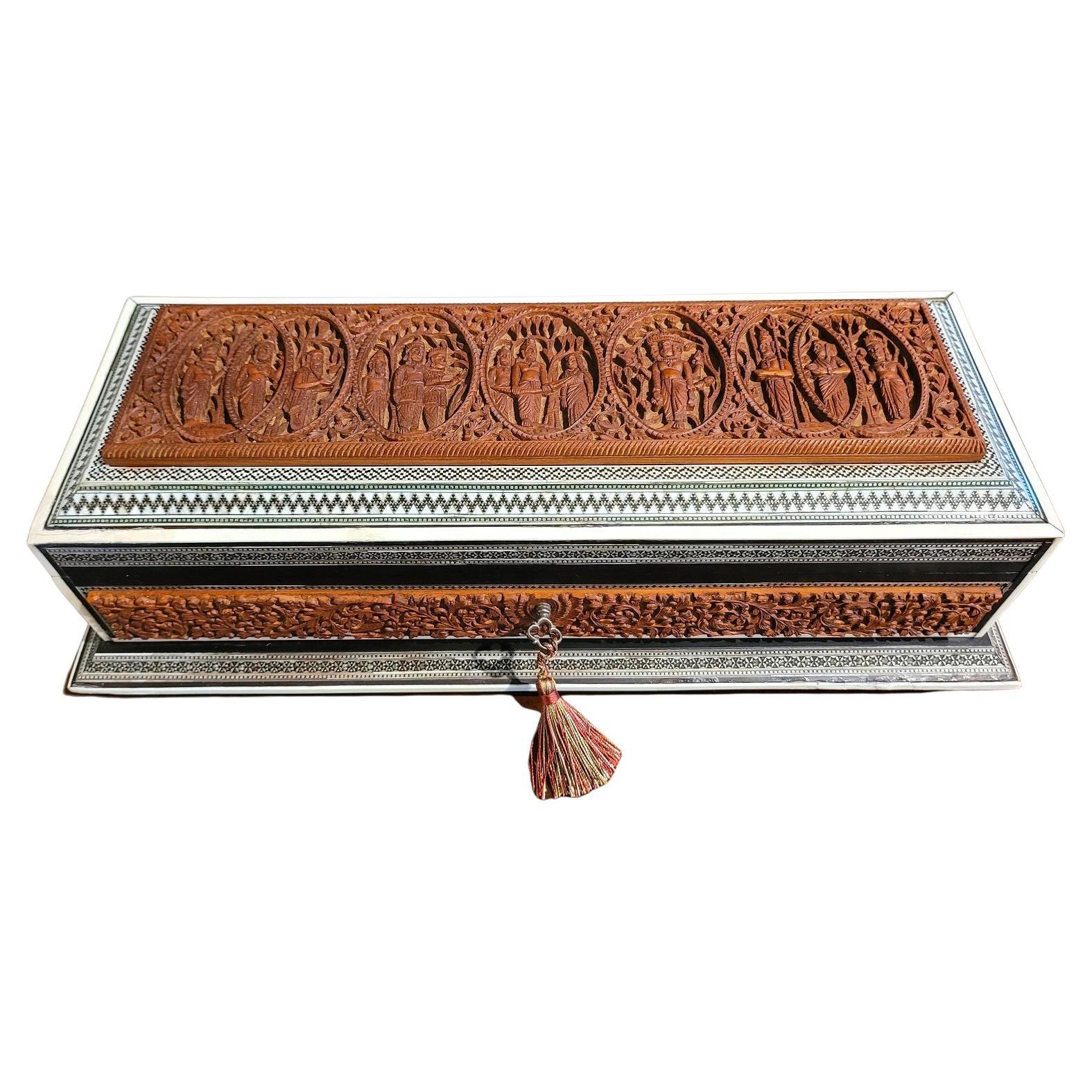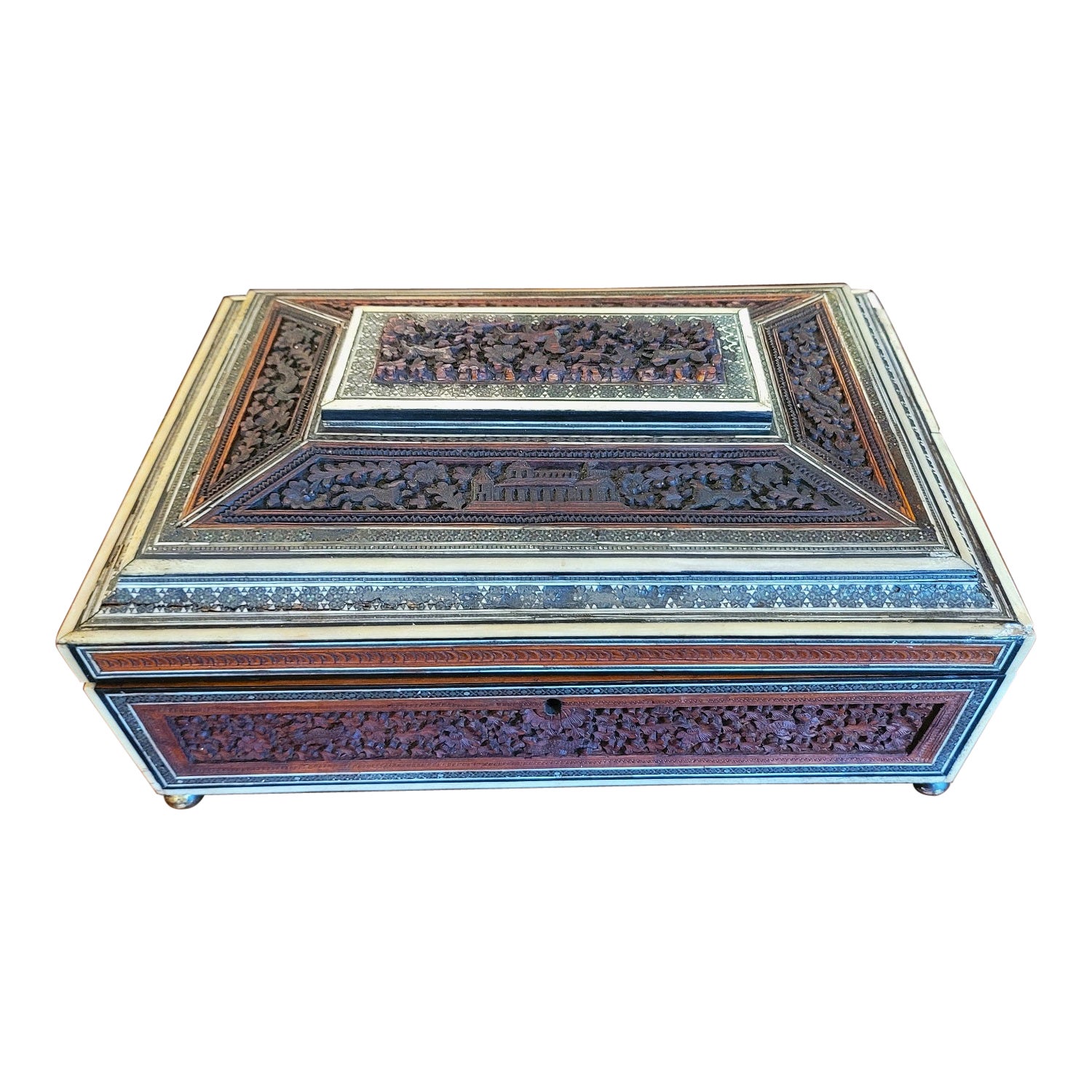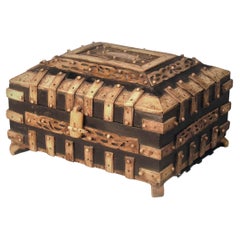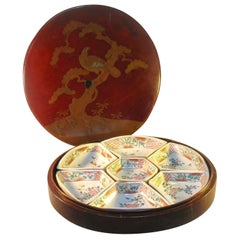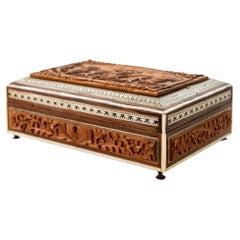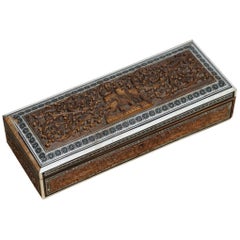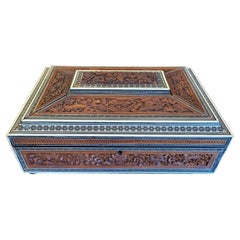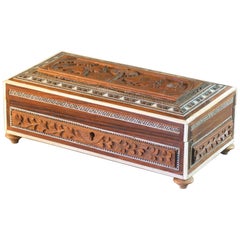
Vizagapatam Carved Sandalwood Bone and Sadeli Mosiac Box
View Similar Items
Want more images or videos?
Request additional images or videos from the seller
1 of 11
Vizagapatam Carved Sandalwood Bone and Sadeli Mosiac Box
About the Item
- Dimensions:Height: 2.75 in (6.99 cm)Width: 8 in (20.32 cm)Depth: 4 in (10.16 cm)
- Style:Anglo-Indian (In the Style Of)
- Materials and Techniques:
- Place of Origin:
- Period:
- Date of Manufacture:20th Century
- Condition:Wear consistent with age and use.
- Seller Location:Ottawa, CA
- Reference Number:1stDibs: LU1417217919482
About the Seller
5.0
Gold Seller
These expertly vetted sellers are highly rated and consistently exceed customer expectations.
Established in 1989
1stDibs seller since 2015
414 sales on 1stDibs
Typical response time: 2 hours
More From This SellerView All
- Very Decorative Vizagapatam Box INDIA 19th CenturyLocated in Ottawa, OntarioVERY DECORATIVE VIZAGAPATAM BOX Vizagapatam, India, 19th Century. Rustic workmanship will only add to the decorative appeal of this Anglo-Indian footed domed casket in ebonized woo...Category
Antique 19th Century Indian Anglo-Indian Decorative Boxes
MaterialsBone
- Large Brass Pandan Box, North India, 19th CenturyLocated in Ottawa, OntarioA large brass pandan box North India, 19th century The body with rounded profile and hinged raised lid with engraved and punched decoration centering ...Category
Antique Late 19th Century Indian Anglo-Indian Decorative Boxes
MaterialsBrass
- Japanese 7-Pcs, Arita Sweetmeat Set & Matching Lacquer Box Meiji Period, 1880sLocated in Ottawa, OntarioA seven-piece Japanese Arita Sweetmeat set and matching lacquer box, Meiji period (1880-1890). Comprising of a central hexagonal dish and six-fan shaped ...Category
Antique Late 19th Century Japanese Meiji Lacquer
MaterialsPorcelain, Lacquer
- Royal Copenhagen Circular Biscuit Plaque & Fine Terracotta Circular BoxBy Bertel ThorvaldsenLocated in Ottawa, OntarioA Royal Copenhagen Circular biscuit plaque 20th century Measure: 5 1/2 In.(14 Cm.) diameter Together With, Fine terracotta circular box by Carl B...Category
Antique Late 19th Century Danish Greek Revival Decorative Boxes
MaterialsTerracotta
- Chinese Hexagonal Cast Brass Tea CaddyLocated in Ottawa, OntarioA Chinese hexagonal cast brass tea caddy, early 20th century. Each rectangular side with a shou symbol surrounded by five stylized bats on blue enamel ...Category
Early 20th Century Chinese Chinese Export Metalwork
MaterialsBrass
- Sterling Navette Form Dutch Scene Gilt Interior Tea Caddy British Import MarkBy Samuel Boyce LandeckLocated in Ottawa, OntarioA sterling silver navette form Dutch scene gilt interior tea caddy with British import mark, makers mark SBL for Samuel Boyce Landeck, (Sheffield 1897). Decorated with couples in a t...Category
Antique 1890s English British Colonial Tea Caddies
MaterialsSterling Silver
You May Also Like
- Antique Anglo-Indian Vizagapatam Jewelry Inlaid Sadeli Footed BoxLocated in North Hollywood, CAAntique 19th century Anglo-Indian jewelry, trinket footed box, inlay with ebony, mosaic marquetry Sadeli work and a carved Hindu scene on top. The box case is made from sandalwood wi...Category
Early 20th Century Indian Anglo-Indian Decorative Boxes
MaterialsWood, Bone, Mother-of-Pearl
- 19th Century Anglo Indian Vizagapatam Carved Sandalwood Box Micro Mosaic InlaysLocated in GBWe are delighted to offer for sale this lovely 19th century Anglo-Indian Vizagapatam carved sandalwood and inlaid box Mid-19th century Anglo-Indian Vizagapatam carved sandalwood box...Category
Antique 19th Century Indian Anglo-Indian Decorative Boxes
MaterialsWood
$268 Sale Price30% Off - 19C Anglo Indian Highly Carved Padouk and Sandalwood Sadeli Mosaic Sarcophagus SLocated in Dallas, TXPRESENTING A GORGEOUS 19C Anglo Indian Highly Carved Padouk and Sandalwood Sadeli Mosaic Sarcophagus Sewing Box. Made in Bombay, India circa 1860-80. Box made of sandalwood with highly carved padouk wood reliefs and panels on all sides. Edged with bone and ebony veneers and glorious sadeli mosiac, made from tiny pieces of faux ivory, pewter, green semi-precious stone. The box is in a sarcophagus form with domed lid. The original brass carry handles are on the sides. The interior is in great condition and consists of a removeable mirror under the lid portion, with the original red velvet lining behind it. The base is removeable and contains a number of lidded compartments. 6 of the interior lids on the base, are each inlaid with sadeli mosaic banding. The rest are also carved and chased. The interior is fully complete with 7 lidded faux ivory/bone, thread canisters with sadeli domes and the original bone thimble. The box sits on 4 brass ball or bun feet with the original velvet lining on the base. Some minor repairs and losses, but this box is fully complete. This is ‘rare’ as many of these boxes have not survived in such condition! Included in the sale are 2 photos that were in the box (under the base tray). Interestingly, one of them is a view of downtown Nassau, New Providence (Bermuda) from the early 20C and stamped on the rear. What a ‘journey’ this piece has made! Made in India … travelled to Bermuda, probably via Britain … back to Ireland (where we bought it) …. then to Texas! These boxes were made by superb Indian craftsmen, specifically for sale to the ruling British elite. These types of boxes, carved padouk and sandalwood, (whilst beautiful and superbly crafted) were of a lesser quality, than the more profusely and intricately mosaic inlay, tortoiseshell and ivory boxes, made for the British ‘Upper Classes’ in the areas of Bombay and Vizagapatam. These type of boxes were much more affordable back in 1880 (and indeed today) and would probably have been bought by mid-level diplomats, civil servants or visitors. Sewing boxes (in general), were in EVERY Victorian home in Britain in the 19th Century and like other boxes etc were ‘status symbols’ of your place in society! The more ornate the box, the more ‘Upper Class’ you were! Of it’s type, this one, is one of the very higher quality one’s, than the norm! SADELI MOSAIC: “Anglo Indian boxes were made in India for the English residents from the early part of the 18th century. They were brought back or sent back to England usually by the people who had commissioned them. From the beginning of the nineteenth century they were imported more commercially, although not in any significant numbers until the middle decades. They were very highly valued, especially the early ones, to the extent that the designs were copied on late 19th and early 20th century tins. The ancient art of Sadeli Mosaic is said to have been introduced from Shiraz in Persia via Sind to Bombay, a long time before the Anglo Indian boxes were made. It was a technique, which required a high degree of skill and patience. It was executed very lavishly, in that the frequent cuts wasted a great amount of the precious materials used. The workmanship was however more than commensurable to the value of the materials. Ivory, silver, pewter (or other metals), wood and horn were cut into faceted rods which were bound together to form geometric patterns. When the glue has set, the rods were sliced in transverse sections. This gave the maker a number of angled circular pieces in the original pattern. Several variations of patterns could be achieved by combining the materials in different ways. The ivory was sometimes dyed green to give an extra color. The mosaic pieces in a combination of patterns, often separated by ivory, ebony, horn or silver stringing were used to veneer sandalwood boxes. In the early boxes, which date from the turn of the 18th to the 19th century, there are large panels of mosaic covering tops and sides of boxes. It took incredible skill to cover such large areas without any shakes or wavering of the pattern. The corners and joins on these boxes are impeccably matched. The makers (reputed to be Persian) of Sadeli mosaic made in the first two decades of the 19th century displayed a total understanding of the qualities of the different materials they used. They combined substances, which can expand and contract according to atmospheric conditions with others, which are hard and unyielding. The result was a sharp definition of the lines and patterns, which made up the whole design. On the early boxes the designs look deceptively simple. The fact is, they emerged from a culture, which had mastered geometry and understood how to generate a pattern from a set number of points. The patterns are so harmoniously combined that their incredible complexity is not immediately apparent. The earliest Sadeli boxes...Category
Antique 19th Century Indian Anglo-Indian Decorative Boxes
MaterialsBone, Padouk, Sandalwood
- Vizagapatam Anglo-Indian Rectangular Box with Bone InlaidLocated in North Hollywood, CAFabulous Anglo-Indian decorative box inlaid. Made in Vizagapatam, situated on the south east coast of India, near Madras. Great decorative inlaid pen box or jewelry box. Inside dimen...Category
20th Century Indian Anglo-Indian Decorative Boxes
MaterialsSandalwood
- 19C Anglo Indian Vizagapatam Bone and Shell Domed Stationery BoxLocated in Dallas, TXPRESENTING A LOVELY 19C Anglo Indian Vizagapatam Bone and Shell Domed Stationery Box – ‘Alice’s Box’. Made in Vizagapatam, India, circa 1860-80. We call this one: “Alice’s Box”! It has lived ‘a hard, well used and traveled life’, as is evident from the number of losses and repairs, as is obvious from the photos, especially to the faux ivory panels and bands to the top. The bonus to the loss of the frieze panels to the dome has a ‘bonus’, however, as their loss has revealed the most GORGEOUS faux blonde tortoiseshell underneath! The box is dome/casket shaped. The top has 3 bands, with the center one being the original. The 2 side bands are later ivorine. The faux ivory and hand-painted medallions on the domed lid, have been saved and they depict Hindu Gods, Vishnu and Shiva. The front and side panels are still in pretty good shape and are decorated with lac ink (indelible ink made from crushed beetles) depicting lovely floral designs. The domed lid open to reveal a series of open compartments for envelopes, writing paper etc. and one lidded panel for stamps. Inside the box are 2 paper labels: one probably being the original item ticket and the other with: ” Alice’s address is 272 Ashworth Ave, Toronto 4, Ontario”. Probably, the original owner? Hence, we call it ‘Alice’s Box’. What a journey/life this box has had! Made in India, made its way to Canada, back to Ireland and then to Texas! This is why, WE LOVE ANTIQUES...Category
Antique 19th Century Indian Anglo-Indian Decorative Boxes
MaterialsBone, Shell, Sandalwood
- Regency Anglo Indian Quill Work Vizagapatam Sandalwood Sewing BoxLocated in New York, NYThis fine Regency period quill work, bone, ivory & sandalwood sewing box with intact interior w sewing implements.Category
Antique Early 19th Century Indian Regency Decorative Boxes
MaterialsBone, Sandalwood, Ivory
$13,200 Sale Price20% Off
Recently Viewed
View AllMore Ways To Browse
Vintage Box Frames
3 Sided Box
Carved Decorative Panel
Vintage Box Vintage 20box Boxes
Bone Carved
Carved Bone Furniture
Two Tigers
India Box
Hand Carved Decorative Panels
Hand Carved Bone
Boxes In Bone
Carved Antler
Indian Bone
Inlaid Decorative Panel
4 Panel 2 Sided Panels
Mosaic Box
Vintage Indian Top
Vintage Inlaid Box
